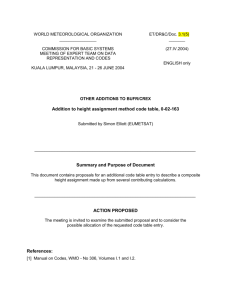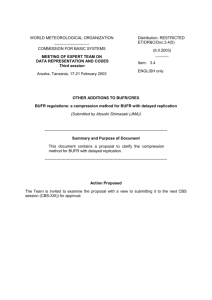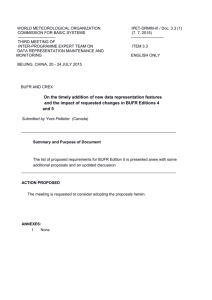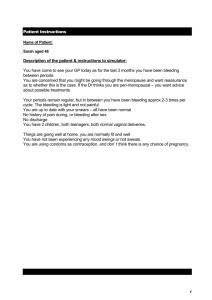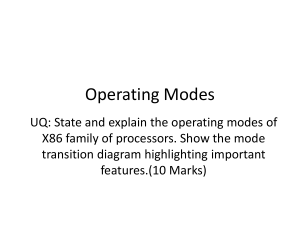FM 94–XIV BUFR
advertisement
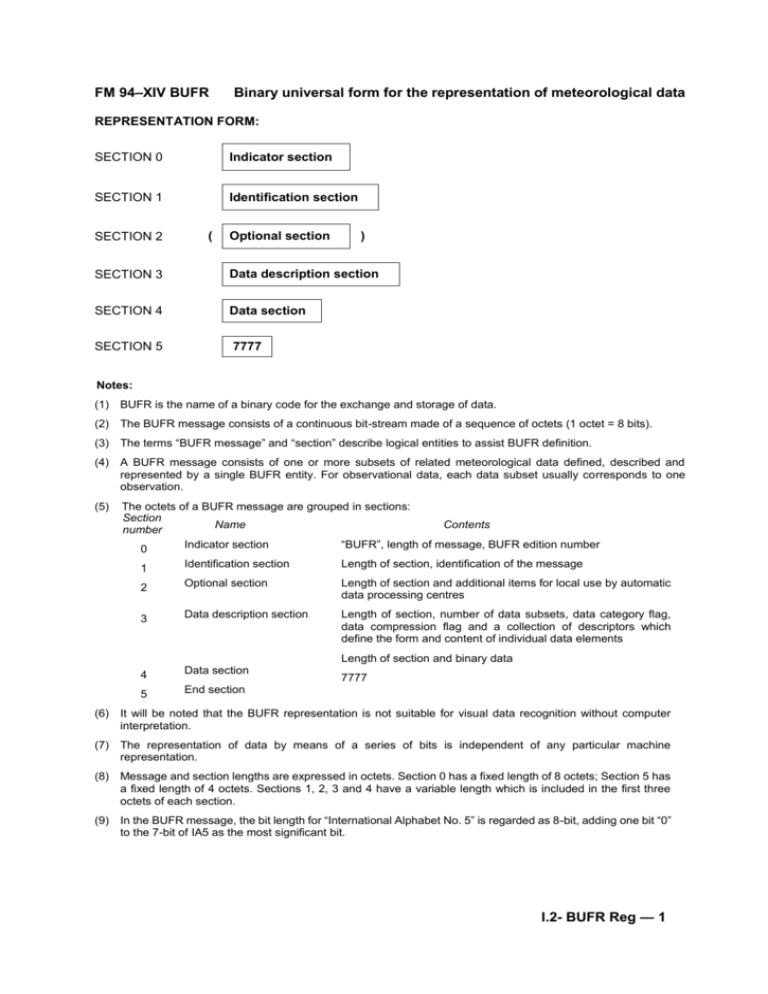
FM 94–XIV BUFR Binary universal form for the representation of meteorological data REPRESENTATION FORM: SECTION 0 Indicator section SECTION 1 Identification section SECTION 2 ( Optional section ) SECTION 3 Data description section SECTION 4 Data section SECTION 5 7777 Notes: (1) BUFR is the name of a binary code for the exchange and storage of data. (2) The BUFR message consists of a continuous bit-stream made of a sequence of octets (1 octet = 8 bits). (3) The terms “BUFR message” and “section” describe logical entities to assist BUFR definition. (4) A BUFR message consists of one or more subsets of related meteorological data defined, described and represented by a single BUFR entity. For observational data, each data subset usually corresponds to one observation. (5) The octets of a BUFR message are grouped in sections: Section Name Contents number Indicator section “BUFR”, length of message, BUFR edition number 0 1 Identification section Length of section, identification of the message 2 Optional section Length of section and additional items for local use by automatic data processing centres 3 Data description section Length of section, number of data subsets, data category flag, data compression flag and a collection of descriptors which define the form and content of individual data elements 4 Data section 5 End section Length of section and binary data 7777 (6) It will be noted that the BUFR representation is not suitable for visual data recognition without computer interpretation. (7) The representation of data by means of a series of bits is independent of any particular machine representation. (8) Message and section lengths are expressed in octets. Section 0 has a fixed length of 8 octets; Section 5 has a fixed length of 4 octets. Sections 1, 2, 3 and 4 have a variable length which is included in the first three octets of each section. (9) In the BUFR message, the bit length for “International Alphabet No. 5” is regarded as 8-bit, adding one bit “0” to the 7-bit of IA5 as the most significant bit. I.2- BUFR Reg — 1 FM 94 BUFR REGULATIONS: 94.1 General 94.1.1 The BUFR form shall be used for the binary representation of meteorological data for exchange and storage. BUFR is particularly suitable for meteorological data that cannot be represented using FM 92 GRIB. 94.1.2 The beginning and the end of the code form shall be identified by 4 octets coded according to the International Alphabet No. 5 to represent, respectively, the indicators BUFR and 7777 in Indicator section 0 and End section 5. All other octets included in the code shall represent data in binary form. Regulation for BUFR edition 3: 94.1.3 Each section included in the code form shall always contain an even number of octets. This rule shall be applied by appending bits set to zero to the section where necessary. Regulation for BUFR edition 4: 94.1.3 Each section included in the code form shall always contain an integer multiple of 8 bits (octet). This rule shall be applied by appending bits set to zero to the section where necessary. 94.1.4 By convention, reserved values in sections 1 to 4 shall be set to zero. 94.1.5 Missing values shall be set to fields of all ones (e.g. each octet shall be set to 11111111 binary). This shall apply to code tables as well as data elements; flag tables shall be augmented to contain a missing indicator bit where this is deemed to be necessary. This regulation does not apply to the data description operator qualifiers in Class 31 of Table B. 94.1.6 The convention for representing missing data for compressed data within the binary Data section shall be to set the corresponding increments to fields of all ones. 94.1.7 When a local reference value for a set of element values for compressed data is represented as all ones, this shall imply that all values in the set are missing. 94.2 Section 0 – Indicator section Section 0 shall be 8 octets long. Octets 1 to 4 shall be character coded according to the International Alphabet No. 5 as BUFR. The remainder of the section shall contain the length of the entire BUFR message (including the Indicator section) expressed in binary form over octets 5 to 7 (i.e. 24 bits), followed by the BUFR edition number, in binary, in octet 8. 94.3 Section 1 – Identification section 94.3.1 The length of the section, in units of octets, shall be expressed in binary form over the group of the first three octets of the section. 94.3.2 Octet 8 of the section shall be used to indicate the inclusion or the omission of section 2. 94.4 Section 2 – Optional section 94.4.1 Regulation 94.3.1 shall apply. I.2 - BUFR Reg — 2 FM 94 BUFR 94.4.2 Octet 5 and subsequent octets shall contain additional items as may be defined within each centre for its own use. 94.5 Section 3 – Data description section 94.5.1 Regulation 94.3.1 shall apply. 94.5.2 Octets 5 and 6 of the section shall be used as a 16-bit number to indicate the number of data subsets within the BUFR message. Octet 7 shall be used to indicate whether observed data or other data are reported, and whether data are compressed or not. Octet 8 and subsequent octets shall contain a collection of descriptors which define the form and content of individual data elements in the Data section. A “data subset” shall be defined as the subset of data described by one single application of this collection of descriptors. 94.5.3 Data description syntax for BUFR 94.5.3.1 Data description shall consist of one or more descriptors. Each descriptor shall occupy 2 octets and contain 3 parts: F (2 bits), X (6 bits) and Y (8 bits). 94.5.3.2 If F = 0, the descriptor shall be called an “element descriptor”. An element descriptor shall define a single data item by reference to Table B. Notes: (1) X denotes the Table B class, Y denotes the element within that class. The corresponding data item is depicted according to the definition contained in Table B, unless otherwise modified. (2) The definition(s) of one or more data item(s) may be modified by means of data description operators. 94.5.3.3 Element descriptors corresponding to the following classes in Table B shall remain in effect until superseded by redefinition: Class 01 Identification 02 Instrumentation 03 Reserved 04 Location (time) 05 Location (horizontal – 1) 06 Location (horizontal – 2) 07 Location (vertical) 08 Significance qualifiers 09 Reserved Note: Redefinition is effected by the occurrence of element descriptors which contradict the preceding element descriptors from these classes. If two or more elements from the same class do not contradict one another, they all apply. 94.5.3.4 The consecutive occurrence of two identical element descriptors or identical sets of element descriptors from classes 04 to 07 inclusive shall denote a range of values bounded by the corresponding element values. This enables the definition of layers and simple time periods. 94.5.3.5 The definition of line, areas, volumes and more complex time attributes shall be accomplished using descriptors from class 04 to 07 in association with suitable descriptors from class 08. I.2 - BUFR Reg — 3 FM 94 BUFR 94.5.3.6 The consecutive occurrence of two or more non-identical element descriptors from classes 04 to 07 inclusive shall infer that all such elements remain in effect until redefined, unless such elements define an increment. 94.5.3.7 Data items defined by element descriptors in class 10 or above shall not behave as coordinates with respect to subsequent data. 94.5.3.8 Increments: Any occurrence of an element descriptor from classes 04 to 07 which defines an increment shall indicate that the location corresponding to that class shall be incremented by the corresponding data value. In the case of successive increments from the same class, this means that each increment shall apply in a cumulative manner, with all preceding increments remaining in effect. Displacements: In contrast, any displacement descriptor from classes 04 to 07 does not redefine the location corresponding to that class, but shall define only a transient displaced location from the location corresponding to that class. In the case of successive displacements from the same class, this means that each displacement shall apply independently and in a non-cumulative manner to the location corresponding to that class. 94.5.3.9 If a BUFR message is made up of more than one subset, each subset shall be treated as though it was the first subset encountered. 94.5.4 The replication operation 94.5.4.1 If F = 1, the descriptor shall be called a “replication descriptor”. For this case, X shall indicate the number of descriptors to be repeated, and Y the total number of occurrences (replications) of the repeated subsequence. Note: Where a replication operation includes delayed replication(s) within the scope of its replication, the replication (or repetition) factor descriptor(s) from class 31 shall be counted for X, except the one (if any) located immediately after the replication description for which X is being calculated, as in the following example: 106000 031001 008002 103000 031001 005002 006002 010002. 94.5.4.2 A value of Y = 0 associated with the replication descriptor shall indicate delayed replication. In this case, the replication data description operator shall be completed by the next element descriptor, which shall define a data item indicating the number of replications. This descriptor may also indicate (by its value of Y) that the following datum is to be replicated together with the following descriptor. 94.5.4.3 Time or location increment descriptors, from classes 04 to 07 inclusive, may be associated with replication descriptors in the following way: when an increment descriptor immediately precedes a replication descriptor, or is separated from it by one or more operator descriptors from Table C, this shall infer that all such increments be applied for each replication; the application of the increments shall have effect from the beginning of each defined replication, including the first. 94.5.5 Further operations on element and sequence descriptors 94.5.5.1 If F = 2, the descriptor shall be called an “operator descriptor”. An operator descriptor shall define an operation by reference to Table C. Notes: (1) X denotes the value corresponding to an operator defined within Table C. (2) Y contains a value to be used as an operand in completing the defined operation. 94.5.5.2 When the Y operand of any operator descriptor, or a count associated with it, refers to a specific number of descriptors preceding the operator, this shall infer that those preceding descriptors are all from Table B or C, i.e. all references to Table D descriptors shall have been completely resolved. Any forward reference to descriptors shall infer that the descriptors are enumerated as they are found in the original record, i.e. Table D descriptors are not expanded. I.2 - BUFR Reg — 4 FM 94 BUFR 94.5.5.3 A data present bit-map shall be defined as a set of N one bit values corresponding to N data entities described by N element descriptors (including element descriptors for delayed replication, if present); the data description of a data present bit-map is comprised of a replication operator followed by the element descriptor for the data present indicator. Notes: (1) Where an operator descriptor requires a data present bit-map of length N to complete the operator definition, the N consecutive element descriptors which correspond to the N data entities to which the N bit values refer shall end with the element descriptor which immediately precedes the first such operator, or with the element descriptor which immediately precedes the first occurrence of such an operator following the occurrence of a cancel backward reference operator. (2) All references to previously defined element descriptors effected through the application of operators which are qualified by data present bit-maps shall refer to the element descriptors concerned including any modifications resulting from change data width, change reference value, and change scale factor. (3) The define data present bit-map for re-use operator enables a data present bit-map to be defined and later re-used; the definition of a data present bit-map shall remain defined until the occurrence of a cancel defined data present bit-map operator or a cancel backward data reference operator. (4) Where an operator descriptor is qualified by a data present bit-map of length N there shall be defined a number of values of the type indicated by that operator together with subsequent appropriate element descriptors; the number of values defined shall correspond to the number of bits set to zero in the data present bit-map; the description of each data item shall be obtained by substituting the appropriate element descriptors, modified by the operator, at each subsequent occurrence of a marker operator. 94.5.6 Indirect reference to descriptors 94.5.6.1 If F = 3, the descriptor shall be called a “sequence descriptor”. A sequence descriptor shall define a list of element descriptors, replication descriptors, operator descriptors and/or sequence descriptors by reference to Table D. Note: X denotes the Table D category, Y denotes the entry within the category. Table D entries contain lists of commonly associated descriptors for convenience. 94.5.6.2 A sequence descriptor shall be equivalent to the corresponding list of descriptors in Table D. Note: If a sequence descriptor is included within the scope of a replication descriptor 1 X Y, the number of descriptors to be repeated shall be modified if the sequence descriptor is replaced by the corresponding list of descriptors from Table D. 94.5.7 Unit rules 94.5.7.1 The unit of an element descriptor, when not defined as a code table, flag table or CCITT5, should be based on the International System of Units (SI), established by the eleventh General Conference on Weights and Measures in 1960, and extended at the 1980 Conference. Alternatively, in exceptional cases, consideration may be given to other standard common units used by the data producer and the users, where a convincing case can be made that those units are more appropriate for the intended purpose of the descriptor. In such cases, priority shall be given to units contained in WMO Common Table C-6 or, in the case of descriptors for aviation products, ICAO Annex 5. 94.5.7.2 In cases where an element descriptor is defined as a code table that references values requiring units, Regulation 94.5.7.1 shall apply. 94.6 Section 4 – Data section 94.6.1 Regulation 94.3.1 shall apply. 94.6.2 Reported values shall be coded using the number of bits for each parameter indicated by reference to the sequence descriptors, replication descriptors, operator descriptors, element descriptors and associated tables. I.2 - BUFR Reg — 5 FM 94 BUFR 94.6.3 Values shall be coded in the order indicated by the sequence descriptors, replication descriptors, operator descriptors and element descriptors. Notes: (1) Where more than one data subset is included in a single BUFR message without data compression: (i) The first set of data values shall be in the order defined by the data description, and shall represent the first data subset; (ii) Subsequent sets of data values shall also be in the order defined by the data description, representing subsequent data subsets. (2) Where more than one data subset is included in a single BUFR message, data compression may be used as follows: (i) Values for each data element are grouped into sets, and the sets shall be in the order defined by the data description; the first value in each set shall represent a minimum value for the set; for character data the first value in the set shall be set to all bits zero; however, if the character data values in all subsets are identical, the first value shall represent the character string; this value is termed a “local reference value”, Ro, with respect to the subsequent set of data; (ii) Local reference values shall be coded according to Regulation 94.6.2; (iii) If all values of an element are missing, Ro shall be coded with all bits set to 1s; (iv) The local reference value shall be followed by a 6-bit quantity specifying the number of bits for each increment or for character data, specifying the number of octets needed for representing the character string in the data subsets. However, if the character data values in all subsets are identical, sub-note vii shall apply; (v) Actual values, V, other than character values, will then be obtained as: V=R + Ro + I where R = table reference value Ro= local reference value I = increment; (vi) Missing values will be denoted by setting all bits of the corresponding I to 1s; (vii) Data elements all having the same value throughout a set shall be signified by coding the number of bits required for storing I as zero; in such cases, the increments shall be omitted; (viii) When operators qualified by a data present bit-map are present, it is required that the length and contents of the bit-map shall be identical for each data subset if data compression is to be used; (ix) When delayed replication is present, it is required that the number of replications shall be identical for each data subset if data compression is to be used. In such cases, sub-note vii shall apply when coding the number of replications. 94.7 Section 5 – End section The End section shall always be 4 octets long, character coded according to the International Alphabet No. 5 as 7777. I.2 - BUFR Reg — 5 SPECIFICATIONS OF OCTET CONTENTS Editorial note: click doc or pdf to full list of the SPECIFICATIONS OF OCTET CONTENTS. Notes: (1) Octets are numbered 1, 2, 3, etc., starting at the beginning of each section. (2) In the following, bit positions within octets are referred to as bit 1 to bit 8, where bit 1 is the most significant and bit 8 is the least significant bit. Thus, an octet with only bit 8 set to 1 would have the integer value 1. (3) For encoding data, BUFR edition 3 may be used up to the first Tuesday of November 2012. Edition 4 may be used as from 2 November 2005. A BUFR message shall not mix features of both editions; the content shall be consistent and in accordance with a single edition. It is recommended to use, if possible, the latest edition of BUFR. (4) Specific features for different editions, when different, will be clearly indicated below in sequence. BUFR TABLES, CODE TABLES AND FLAG TABLES FM 94 BUFR refers to three types of tables: BUFR tables, code tables and flag tables. BUFR tables Tables containing information used to describe, classify and define the contents of a BUFR message are called BUFR tables. Four BUFR tables are defined: Tables A, B, C and D. Entry numbering shall be the same in BUFR tables and CREX tables (see definition of FM 95 CREX in Part C, Common Features to Binary and Alphanumeric Codes) for the same entity represented. Table B entries shall be listed in the common BUFR/CREX Table B. Table D common sequences shall not be defined in both BUFR Table D and CREX Table D, unless otherwise a conversion between both Tables D is not simple, that is, the conversion is not completed by simple replacement of part “F” of each descriptor. A new BUFR Table D sequence shall be assigned a number not used by any CREX Table D sequence. Similarly, if a CREX Table D sequence is not defined in BUFR Table D, it shall be assigned a number not used by any BUFR sequence. Code tables and flag tables BUFR Table B defines some elements by means of code tables or flag tables. Within this general description are included code tables referenced by code figures, and flag tables where each bit is set to 0 or 1 to indicate a false or true value with respect to a specific criterion. The concept of a flag table is especially us eful where combinations of criteria are represented. Within BUFR, all code tables and flag tables refer to elements defined within BUFR Table B; they are numbered according to the X and Y values of the corresponding Table B reference. BUFR TABLE RELATIVE TO SECTION 1 BUFR Table A - Data category Editorial note: click doc, pdf, txt or xml to full list of the BUFR Table A - Data category. BUFR TABLES RELATIVE TO SECTION 3 BUFR/CREX Table B - Classification of elements Editorial note: click doc, pdf, txt or xml to full list of the BUFR/CREX Table B - Classification of elements F X 0 00 BUFR/CREX table entries Class Comments Status 0 01 Identification Identifies origin and type of data Operational 0 02 Instrumentation Defines instrument types used Operational Operational 0 03 Reserved Operational 0 04 Location (time) Defines time and time derivatives Operational 0 05 Location (horizontal - 1) Defines geographical position, including horizontal derivatives, in association with class 06 (first dimension of horizontal space) Operational 0 06 Location (horizontal - 2) Defines geographical position, including horizontal derivatives, in association with class 05 (second dimension of horizontal space) Operational 0 07 Location (vertical) Defines height, altitude, pressure level, including vertical derivatives of position Operational 0 08 Significance qualifiers Defines special character of data Operational 0 09 Reserved 0 10 Vertical elements and pressure Height, altitude, pressure and derivatives observed or measured, not defined as a vertical location Operational 0 11 Wind and turbulence Wind speed, direction, etc. Operational 0 12 Temperature 0 13 Hygrographic and hydrological elements 0 14 Radiation and radiance Operational 0 15 Physical/chemical constituents Operational 0 19 Synoptic features 0 20 Observed phenomena 0 21 Radar data Operational 0 22 Oceanographic elements Operational 0 23 Dispersal and transport Operational 0 24 Radiological elements Operational 0 25 Processing information 0 26 Non-coordinate location (time) Defines time and time derivatives that are not coordinates Operational 0 27 Non-coordinate location (horizontal - 1) Defines geographical positions, in conjunction with class 28, that are not coordinates Operational 0 28 Non-coordinate location (horizontal - 2) Defines geographical positions, in conjunction with class 27, that are not coordinates Operational 0 29 Map data Operational 0 30 Image Operational 0 31* Data description operator qualifiers 0 33 Quality information Operational 0 35 Data monitoring information Operational 0 40 Satellite data Operational Operational Operational Humidity, rainfall, snowfall, etc. Operational Operational Defines present/past weather, special phenomena, etc. Operational Operational Elements used in conjunction with data description Operational * This class does not exist in CREX. Notes: (1) Where a code table or flag table is appropriate, “code table” or “flag table”, respectively is entered in the UNITS column. (2) The code tables and flag tables associated with Table B are numbered to correspond with the F, X and Y part of the table reference. (3) To encode values into BUFR, the data (with units as specified in the UNITS column) must be multiplied by 10 to the power SCALE. Then subtract the REFERENCE VALUE to give the coded value found in Section 4 of the BUFR message. For example, a measured latitude is –45.76 degrees. The coarse accuracy descriptor is 0 05 002 and the encoded value is –45.76 x 102 – (–9000) = 4424. (4) Where UNITS are given as CCITT IA5, data shall be coded as character data left justified within the field width indicated using CCITT International Alphabet No. 5, and blank filled to the full field width indicated. (5) Classes 48 to 63 are reserved for local use; all other classes are reserved for future development. (6) Entries 192 to 255 within all classes are reserved for local use. (7) The use of local descriptors, as defined in Notes 5 and 6, in messages intended for non-local or international exchange is strongly discouraged. They should be kept to the barest minimum possible and must also be by-passed by the use of descriptor 2 06 YYY. (8) First-order statistics are included in Table B only when they are produced, as such, by the observing system. (9) In all flag tables within the BUFR specification, bits are numbered from 1 to N from the most significant to least significant within a data of N bits, i.e. bit No. 1 is the leftmost and bit No. N is the rightmost bit within the data width. The bit No. N (least significant bit) is set to 1 only if all the bits are set to 1 within the data width of the fag table to represent a missing value. BUFR Table C - Data description operators (Edition 3) Editorial note: click doc, pdf, txt or xml to full list of the BUFR Table C - Data description operators (Edition 3). BUFR Table C - Data description operators (Edition 4) Editorial note: click doc, pdf, txt or xml to full list of the BUFR Table C - Data description operators (Edition 4). BUFR Table D - List of common sequences Editorial note: click doc, pdf, txt or xml to full list of the BUFR Table D - List of common sequences. F X Category of sequences Status 3 00 BUFR table entries sequences Operational 3 01 Location and identification sequences Operational 3 02 Meteorological sequences common to surface data Operational 3 03 Meteorological sequences common to vertical soundings data Operational 3 04 Meteorological sequences common to satellite observations Operational 3 05 Meteorological or hydrological sequences common to hydrological observations Operational 3 06 Meteorological or oceanographic sequences common to oceanographic observations Operational 3 07 Surface report sequences (land) Operational 3 08 Surface report sequences (sea) Operational 3 09 Vertical sounding sequences (conventional data) Operational 3 10 Vertical sounding sequences (satellite data) Operational 3 11 Single level report sequences (conventional data) Operational 3 12 Single level report sequences (satellite data) Operational 3 13 Sequences common to image data Operational 3 15 Oceanographic report sequences Operational 3 16 Synoptic feature sequences Operational 3 18 Radiological report sequences Operational 3 21 Radar report sequences Operational 3 22 Chemical and Aerosol sequences Operational 3 40 Additional satellite report sequences Operational Notes: (1) From a conceptual point of view, Table D is not necessary: (a) The Data description section can fully and completely describe the data using only element descriptors, operator descriptors and the rules of description; (b) Such a means of defining the data would involve considerable overheads in terms of the length of the Data description section. Table D is a device to reduce these overheads; (c) Each entry within Table D contains a list of descriptors. Each sequence descriptor that references to Table D may be “expanded” by replacing it with the list corresponding to that entry. The process of “expansion” is well defined, provided it results in a set of element descriptors and operator descriptors; (d) Descriptors listed in entries to Table D may themselves refer to Table D, provided no circularity results on repeated expansion; (e) The initial Table D has been limited to lists of descriptors likely to be used frequently. Every attempt has been made not to produce initial tables that are too comprehensive. Minor differences of reporting practice can be accommodated by not endeavouring to reduce each observation type to a single descriptor. Indeed, much more flexibility is retained if the Data description section is envisaged as containing three or four descriptors. (2) It should be noted that, initially, effort has been concentrated on the requirements for observational data. Extensions to forecast data, time series data, products, etc., follow logically, and can be added at an appropriate future date. (3) Category 1 contains common sequences of non-meteorological descriptors; categories 2 to 6 contain common sequences of meteorological descriptors; categories 7 to 21 contain sequences which define reports, or major subsets of reports. (4) Underwater soundings are included, with some minor omissions, to illustrate the facility to describe data of slightly different contents. (5) Satellite data have been split to maximize the benefits of data compression. Compound combinations may easily be defined using the descriptors available. (6) Satellite observation data benefit enormously from being split into fragments (1, 2, 3 . . . 7), then applying data compression to many locations within each fragment. Again, BUFR flexibility enables compound forms to be defined if desired. (7) Categories 48 to 63 are reserved for local use; all other categories are reserved for future development. (8) Entries 192 to 255 within all categories are reserved for local use. CODE TABLES AND FLAG TABLES ASSOCIATED WITH BUFR/CREX TABLE B Editorial note: click doc, pdf, txt or xml to full list of the CODE TABLES AND FLAG TABLES ASSOCIATED WITH BUFR/CREX TABLE B. Note: In developing code tables associated with BUFR/CREX Table B to specify units of elements, the following principles should be applied: (a) Code tables specifying the units for an element which is defined, in the Manual on Codes, by a single symbolic letter shall be compatible with the relevant existing WMO code tables; (b) Code tables combining two or more existing WMO code tables to specify the units for an element which is defined, in the Manual on Codes, by a group of symbolic letters shall be compatible with the combined code figures of the relevant group of symbolic letters; (c) Code tables combining two or more existing WMO code tables to specify the units for an element which is defined, in the Manual on Codes, by different symbolic letters shall be compatible with the code figures of the relevant symbolic letters, with successive tens or hundreds values added, as appropriate; (d) Code tables and flag tables should only be used for reporting qualitative information. Quantitative information should be reported as observed using entries in Table B. “Data description operators” from Table C should be applied when a “scale change” or “data width change” is required; (e) Reference to existing specification(s) and code table(s) in the Manual on Codes, with explanation of possible deviations, shall be given in an additional table annexed to the code tables associated with BUFR/CREX Table B.
